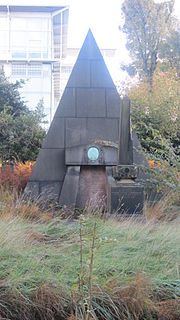- Church of Saint Andrew, Liverpool
-
Church of Saint Andrew, Liverpool 
Church of Saint Andrew, Liverpool,
from the southwest in April 2010Location in Merseyside Coordinates: 53°24′11″N 2°58′22″W / 53.4030°N 2.9727°W OS grid reference SJ 354 900 Location Rodney Street, Liverpool, Merseyside Country England Denomination Scottish Presbyterian History Dedication Saint Andrew Architecture Functional status Redundant Heritage designation Grade II* Designated 28 June 1952 Architect(s) Daniel Stewart, John Foster Architectural type Church Style Greek Revival Groundbreaking 17 June 1823 Completed 1824 Closed 1975 The Church of Saint Andrew, Liverpool, is a ruined church in Rodney Street, Liverpool, Merseyside, England. The church has been designated by English Heritage as a Grade II* listed building,[1] and is on its Buildings at Risk Register.[2]
Contents
History
The church was built in 1823 for Scottish Presbyterians in Liverpool.[3] The foundation stone was laid on 17 June, and the church opened the following year on 3 December.[4] The body of the church was designed by Daniel Stewart, the surveyor of the church's committee of management, and the façade by John Foster the senior surveyor of the Corporation of Liverpool.[3] The church closed in 1975,[4] and was seriously damaged by fire in 1983.[3] Since that time, one of the towers has had to be demolished because it was unsafe. The church and its surrounding graveyard were purchased privately in 1988, with plans to restore the building and open it as offices and medical consulting rooms. However the plans did not not materialise, and the building and site have been acquired by Liverpool City Council. As of 2011, its future is uncertain.[5] On the Buildings At Risk Register, its condition is stated to be "very poor".[2] The Scottish community previously meeting in the church now meet in the Radcliffe Room in Liverpool Cathedral.[6]
Architecture
The body of the church is constructed in rendered brick, and contains round-headed windows. The façade is in ashlar in Greek Revival style. It contains a recessed portico with Ionic columns, and square towers at the corners surmounted by small domes.[3] In the National Heritage List for England it is described as "a distinguished building in a desperate condition".[1]
Mackenzie Monument
Adjacent to the church in the churchyard is a monument to William Mackenzie, a railway contractor who died in 1851. It is in the shape of a pyramid, is constructed in granite, and was erected in 1868. Facing the street is a blind entrance flanked by uprights supporting a lintel containing a bronze plaque. The structure is a Grade II listed building.[7]
There is a tradition that, as Mackenzie was a gambling man, he sold his soul to the Devil, and that his body was placed in a seating position above ground within the pyramid, in order that the Devil may not claim him. His ghost is said to haunt Rodney Street.[5]
References
- ^ a b "Church of Saint Andrew, Liverpool", The National Heritage List for England (English Heritage), 2011, http://list.english-heritage.org.uk/resultsingle.aspx?uid=1361913, retrieved 11 August 2011
- ^ a b Church of Saint Andrew, Liverpool, English Heritage, http://risk.english-heritage.org.uk/2010.aspx?id=993&rt=0&pn=1&st=a&ctype=all&crit=Liverpool, retrieved 11 August 2011
- ^ a b c d Pollard, Richard; Pevsner, Nikolaus (2006), Lancashire: Liverpool and the South-West, The Buildings of England, New Haven and London: Yale University Press, p. 361, ISBN 0-300-10910-5
- ^ a b St Andrew's Scotch Church (Presbyterian), Ancient Egypt, http://www.ancient-egypt.co.uk/liverpool/pyramid/pages/2005-mar-11%20629.htm, retrieved 11 August 2011
- ^ a b Pye, Ken (2011), Discover Liverpool, Liverpool: Trinity Mirror Media, p. 43, ISBN 978-1-906802-90-5
- ^ Welcome, St. Andrew's Church of Scotland, Liverpool, https://sites.google.com/site/liverpoolkirk/, retrieved 11 August 2011
- ^ "Monument to W Mackenzie approximately 7 metres to south of Church of Saint Andrew, Liverpool", The National Heritage List for England (English Heritage), 2011, http://list.english-heritage.org.uk/resultsingle.aspx?uid=1361914, retrieved 11 August 2011
Categories:- Churches in Liverpool
- Presbyterianism in England
- Grade II* listed buildings in Liverpool
- Grade II* listed churches
- Religious buildings completed in 1824
- Presbyterian congregations established in the 19th century
- Church of Scotland churches in England
- 19th-century Presbyterian church buildings
- Presbyterian churches in England
Wikimedia Foundation. 2010.


